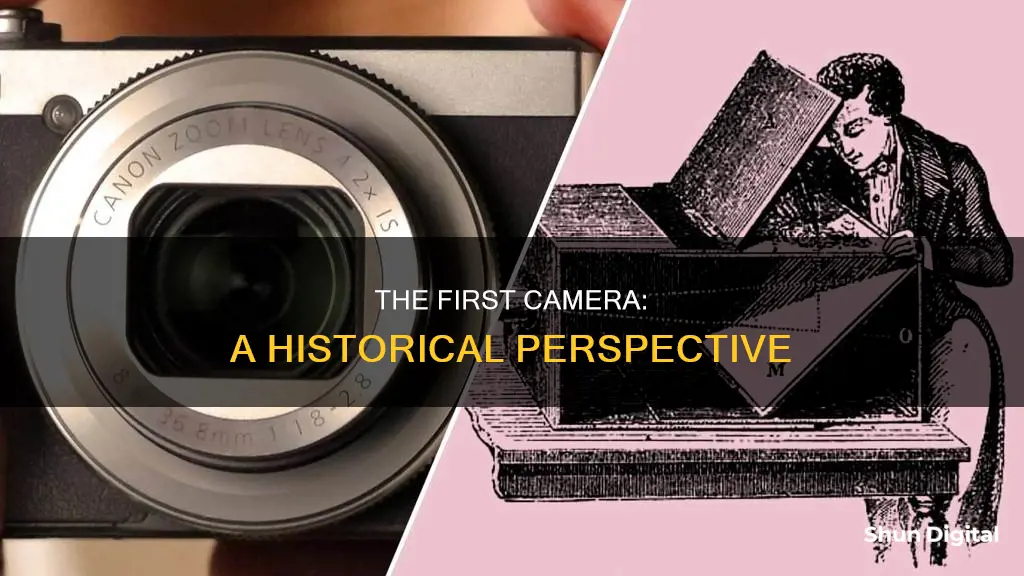
The history of the camera is a long and fascinating one, spanning centuries and involving numerous inventors and innovations. The first camera, or at least the first device that resembles what we now understand as a camera, was invented around the 4th century BCE. This ancient device, known as the camera obscura, was a dark room with a small hole that projected an inverted image of the outside world onto its walls. Fast forward to the 16th century, and the addition of rudimentary lenses improved image sharpness, leading to the creation of portable versions by the 17th century.
The story of the camera's evolution includes many notable figures, such as philosophers, alchemists, scientists, and artists. One of the most significant milestones in the history of photography came in 1826 when Joseph Nicephore Niepce used a camera obscura to capture the world's first permanent photograph. Niepce's pioneering use of a light-sensitive substance and long exposure times enabled him to create a lasting image, a groundbreaking achievement in the history of visual capture.
While Niepce is often credited as the inventor of the first camera, the story doesn't end there. Other inventors built upon his work, refining the technology and processes to improve image quality and reduce exposure times. Louis Daguerre, for example, collaborated with Niepce and made significant advancements, including the use of iodized silver plates and mercury vapour for development, resulting in sharper images and shorter exposure times. This led to the daguerreotype camera, which became the first photographic camera developed for commercial manufacture in 1839.
The journey towards the modern camera continued with innovations in film, portability, and convenience. George Eastman's introduction of flexible roll film in the 1880s revolutionised photography, making it more accessible to amateurs. The Kodak camera, introduced in 1888, allowed users to take up to 100 photos before changing the film, bringing photography to the masses.
The evolution of the camera continued with the introduction of 35mm film, instant cameras, digital cameras, and eventually, smartphone cameras. Each advancement brought us closer to the high-quality, portable, and versatile cameras we know today.
| Characteristics | Values |
|---|---|
| Date of invention | 1685 (first portable camera) or 1816 (first photographs) |
| Inventor | Johann Zahn (first portable camera) or Joseph Nicéphore Niépce (first photographs) |
| Image type | Non-permanent pictures |
| Image medium | Silver chloride-coated paper |
What You'll Learn

The first camera was the camera obscura
The camera obscura is a darkened room or enclosed box with a tiny opening on one side, through which light passes and projects a hazy picture of the outside world onto the walls or screens inside. The earliest known written record of this idea dates back to Han Chinese scholar Mozi (c. 470 to c. 391 BC), who correctly argued that the inversion of the image is a result of light travelling in straight lines from its source.
By the 5th century BC, the camera obscura was being used to aid drawing and painting. By projecting an image onto a surface, artists were able to accurately capture perspective and represent the height, width, depth and relative position of what they could see in the 3D world on a 2D flat surface.
In the 11th century, Arab physicist Ibn al-Haytham (Alhazen) published optics books that featured light tests through a tiny hole in a darkened chamber (camera obscura). He is often credited with the invention of the pinhole camera and is regarded by many as a legitimate inventor.
In the 15th century, Leonardo da Vinci wrote the first clear description of the camera obscura in his Codex Atlanticus. He also sketched around 270 illustrations of camera obscura systems in his art books over the years and linked them to the human eye.
By the 16th century, lenses were being used in the openings of walls or closed window shutters in dark rooms to project images, aiding in drawing. By the late 17th century, portable camera obscura devices in tents and boxes had come into use as drawing tools.
Drone Camera Battery Life: How Long Can You Fly?
You may want to see also

The first photograph was taken in 1826
Niépce's photograph was a significant milestone in the history of photography and paved the way for further developments in camera technology. Unfortunately, Niépce did not achieve commercial success with his invention and died in 1833, just a few years after taking the first photograph. However, his contributions to the field of photography are undeniable, and he is rightfully recognized as the world's first photographer.
The first photograph was a result of centuries of advancements in chemistry and optics, with the camera obscura playing a crucial role in its development. The camera obscura, which means "dark room" in Latin, is a device that projects an inverted image of a scene through a small aperture onto a surface. This principle was first described by Han Chinese philosopher Mozi around 470 to 391 BC. Over the centuries, artists and scientists experimented with the camera obscura, refining its design and exploring its potential.
By the time Niépce built his prototype camera in 1816, portable box camera obscurae suitable for photography were widely available. Niépce's camera, made by Parisian opticians Charles and Vincent Chevalier, was a sliding wooden box with a lens that allowed him to capture the world's first photograph. This groundbreaking invention laid the foundation for modern photography and inspired future innovators to improve and build upon his work.
Mastering Camera Raw White Balance
You may want to see also

The first photographer was Joseph Nicéphore Niépce
Niépce was born in Chalon-sur-Saône, Saône-et-Loire, France, in 1765. His father was a wealthy lawyer, and he had an older brother, Claude, with whom he collaborated on research and invention. Niépce served as a staff officer in the French army under Napoleon and later became the Administrator of the district of Nice in post-revolutionary France. However, he resigned from this position in 1795 to pursue scientific research with his brother.
Niépce's interest in photography began with his fascination with the newly invented art of lithography, which swept over France in 1813. He started his initial experiments by 1816, unable to draw well, and first placed engravings, made transparent, onto stones coated with light-sensitive varnish. He also applied the then-popular optical instrument, the camera obscura, in his experiments.
In 1824, Niépce met with some success in copying engravings, but it wasn't until 1826 that he utilized pewter plates as the support medium for the process. By the summer of that year, he had set up a camera obscura in the window of his upper-story workroom at his country house, Le Gras. He placed a polished pewter plate coated with bitumen of Judea, an asphalt derivative of petroleum, within the camera and uncapped the lens. After an eight-hour exposure, the plate was removed, and the latent image was rendered visible by washing it with a mixture of oil of lavender and white petroleum, which dissolved the parts of the bitumen that had not been hardened by light.
This resulted in the world's first photograph, a permanent direct positive picture of the view from the window, including the outbuildings, trees, and landscape. This photograph, now known as "View from the Window at Le Gras," is housed at the Harry Ransom Center at the University of Texas at Austin.
Niépce called his photographic process heliography, which means "sun drawing." He had initially experimented with capturing images on paper coated with silver chloride, but these images were negatives and would eventually darken all over when brought into the light. With heliography, he captured the world's first permanent photographic image, a contact-exposed copy of an engraving of Pope Pius VII, created in 1822. However, this image was later destroyed when Niépce attempted to make prints from it.
In 1827, Niépce travelled to England, where his brother Claude was living, and attempted to generate interest in his heliographic process from the Royal Society. However, he was unsuccessful, and upon his return to France, he formed a partnership with the French artist Louis Jacques Mandé Daguerre in 1829. Together, they developed the physautotype, an improved process using lavender oil distillate as the photosensitive substance. Unfortunately, Niépce died in 1833, just a few years after forming this partnership, and his contributions to the development of photography largely went unrecognized during his lifetime.
It was only later, in 1952, that photohistorian Helmut Gernsheim was able to track down the world's first photograph and return Niépce to his rightful place as the world's first photographer.
Adjusting GoPro Hero 4 Camera for Wide Shots
You may want to see also

The first camera was portable in 1685
The history of the camera is a long and complex one, stretching back centuries before the first photograph was ever taken. The evolution of image-capturing technology has a rich history involving many great minds and pioneers.
The first device resembling a camera was the camera obscura, which means "dark room" in Latin. This device was a projector invented in the 11th century by the Han Chinese philosopher Mozi. The camera obscura projected an inverted image through a small hole onto a larger screen. For several centuries, various cultures experimented with these room-sized boxes, with Iraqi scientist Ibn describing camera devices in his "Book of Optics" in 1021.
In 1685, German author Johann Zahn designed the first camera that was small and portable enough for practical photography. Zahn's design was a handheld reflex camera, a significant step towards the modern camera. However, it would take nearly 150 years for his ideas to come to fruition.
In the early 19th century, French inventor Joseph Nicephore Niepce made the first camera for photography through a process called heliography. Niepce used a wooden light-proof box with a tiny pinhole and a metal plate inside to capture the image. However, the images on his silver-coated paper were not permanent.
In the 1830s, Niepce's partner, Louis Daguerre, continued to experiment and created the first practical photographic process, which he named the daguerreotype. Daguerre used a silver-plated copper sheet, treated with iodine vapour, to capture images. He then fixed the images with a salt solution, making them permanent.
In 1839, the first daguerreotype camera was commercially manufactured by Alphonse Giroux. This camera had a double-box design, with a landscape lens on the outer box and a holder for a ground glass focusing screen and image plate on the inner box. The daguerreotype camera required long exposure times, but it marked a significant step towards commercial photography.
The history of the first camera is a testament to the ingenuity and perseverance of pioneers like Zahn, Niepce, and Daguerre, who laid the foundation for the modern photography we know today.
Mastering Vignette Effects in Camera Raw
You may want to see also

The first permanent photograph was in 1826
The first permanent photograph was taken in 1826 by French inventor Joseph Nicéphore Niépce. The image, titled 'View from the Window at Le Gras', was captured using a camera obscura and projected onto a pewter plate thinly coated with bitumen of Judea, a naturally occurring asphalt. The bitumen hardened in the brightly lit areas, but in the dimly lit areas, it remained soluble and could be washed away with a mixture of oil of lavender and white petroleum.
Niépce's photograph depicts the buildings and countryside surrounding his estate, Le Gras, as seen from a high window. The image includes the upper loft, or 'pigeon-house', of the family house; a pear tree with a patch of sky showing through an opening in the branches; the slanting roof of the barn, with the long roof and low chimney of the bakehouse behind it; and another wing of the family house.
The photograph required a very long exposure time, with sunlight striking the buildings from opposite sides, suggesting an exposure of around eight hours. However, a modern researcher who studied Niépce's notes and recreated his processes found that the exposure likely continued for several days.
Niépce's pioneering work laid the foundation for the art of photography, which has since undergone numerous advancements and become a ubiquitous part of everyday life.
Understanding FE2 Camera's Battery Functionality
You may want to see also







